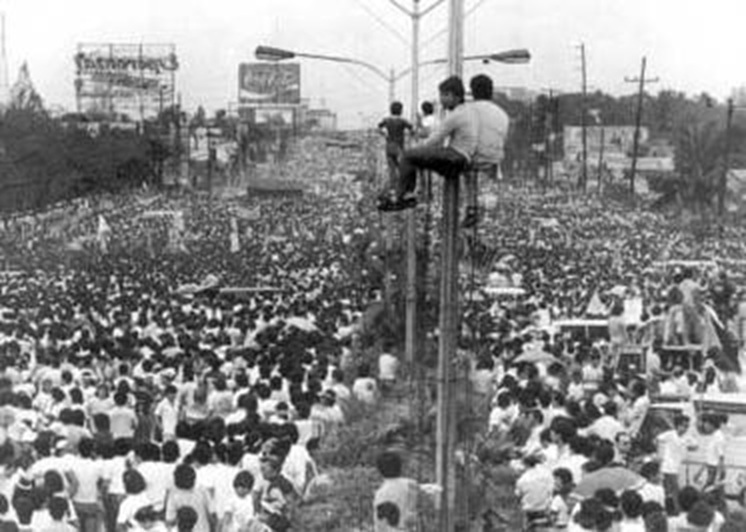An iconic photo of the People Power Revolution in the Philippines in February 1986 showing hundreds of thousands of people filling up Epifanio delos Santos Avenue (EDSA).
Lessons from the Catholic Church in the Philippines
The Catholic Church’s actions during the 1986 People Power Revolution in the Philippines offer powerful lessons for the Church in countries experiencing authoritarianism today.
The Catholic Church in the Philippines played an indispensable role as defender of human rights and mobilizer of civil disobedience, leading to the nonviolent downfall of the Ferdinand Marcos dictatorship and the restoration of democracy.
Moral Conscience
Marcos’s declaration of Martial Law in 1972 brought widespread human rights abuses, rampant corruption, and the dismantling of democratic institutions. As other civil society organizations were co-opted or crushed, the Catholic Church became the last bastion of organized opposition.
Led by Cardinal Jaime Sin, the Church consistently spoke out. Pastoral letters and homilies condemned human rights violations and electoral fraud, providing a crucial counter-narrative to state-controlled media. Church groups, such as the Task Force Detainees of the Philippines (TFDP), which was a part of the Association of Major Religious Superiors in the Philippines, actively documented cases of torture and killings, exposing the true nature of the regime and eroding Marcos’s legitimacy.
Support for Dissidents
During Martial Law, churches and religious institutions became safe havens for dissidents, activists, and those persecuted by the regime. Monasteries, convents, and parish halls provided shelter and meeting places for opposition groups. The anonymity and respect accorded to religious spaces made them difficult for state forces to openly raid without risking significant public backlash.
Individual priests, sisters, and lay workers directly engaged in social justice work, ministering to the poor and marginalized, who were disproportionately affected by the regime’s economic policies and human rights abuses. They not only provided material aid but also fostered a sense of community and solidarity, reinforcing the idea that they were not alone in their suffering and desire for change.
The Catalyst: Assassination and Snap Elections
The assassination of opposition leader Benigno “Ninoy” Aquino Jr. in 1983 dramatically intensified public discontent. The Church, through Cardinal Sin, was among the loudest voices demanding justice and accountability.
When Marcos called for snap elections in 1986 in a desperate attempt to legitimize his rule, the Church again played a decisive role. Cardinal Sin, along with other bishops, urged Filipinos to register and vote, emphasizing that participation was a moral obligation.
More critically, the Church organized the National Citizens’ Movement for Free Elections (NAMFREL). This independent poll-watching body mobilized hundreds of thousands of volunteers to monitor polling precincts, guard ballot boxes, and report instances of fraud. When the official count contradicted NAMFREL’s tally, the Church’s endorsement of NAMFREL’s findings solidified public belief that the elections had been stolen.
The People Power Revolution: A Call to Action
The climax of the Church’s involvement came in the four days of the People Power Revolution (February 22-25, 1986). When Defense Minister Juan Ponce Enrile and Armed Forces Vice Chief of Staff Fidel Ramos broke away from Marcos and barricaded themselves in military camps along Epifanio de los Santos Avenue (EDSA), they were vulnerable to attack by Marcos loyalists.
It was Cardinal Sin’s impassioned radio broadcast that proved to be the pivotal moment. “Go to EDSA. I ask you, my dear people, to support our two brave generals. Bring your rosaries. Bring your Bibles. I bless you,” he declared.
The response was overwhelming. Millions of ordinary Filipinos, spurred by their faith and trust in the Church, streamed onto EDSA.Nuns, priests, and laypeople led prayers, offered food to soldiers, and stood peacefully in front of tanks. There were a number of priests who joined and were very prominent in the movement and gave much inspiration to Catholic believers.
This massive, nonviolent assembly, organized and sustained by the Church’s call, presented an insurmountable moral and physical barrier to Marcos’s forces. Priests and nuns were almost always put in the front lines of rallies to protect the people following.
It was common that the military would fire colored water from the fire trucks. The images of unarmed civilians confronting tanks with rosaries and flowers captivated the world and paralyzed the regime. The soldiers, many of whom were Catholic, found it morally impossible to fire upon their own people, let alone religious figures.
A Blueprint for Resistance
The Church’s ability to transcend political factions and appeal to a deeper sense of national and moral identity proved invaluable. It demonstrated that in the face of an authoritarian regime, a strong, independent religious institution with a commitment to justice and human dignity can serve as an indispensable force for defending human rights and restoring democracy.
Photo: EDSA Revolution in the Philippines. Photo taken by Joey de Vera in February 1986 and available for fair use via Wikimedia commons.

